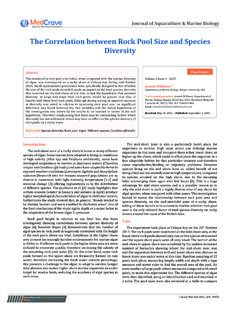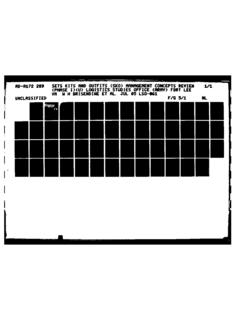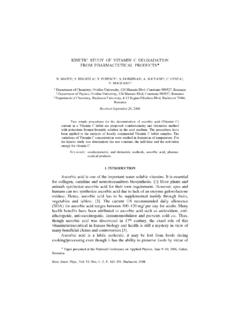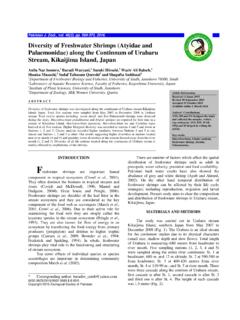Transcription of Canine Lymphoma: Review and What’s New
1 401 Canine lymphoma : Review and what s New Sue Ettinger, DVM, DACVIM Dr. Sue Cancer Vet PLLC Tarrytown, NY Key points lymphoma is a common Canine cancer and is a systemic disease that requires chemotherapy in almost all cases. The majority of dogs achieve a complete remission with chemotherapy (approximately 80%). Higher remission rates are typical with CHOP multi-agent chemotherapy protocols. Early accurate diagnostics and careful staging are keys to proper clinical decision making. To determine the best protocol for a patient and owners, it is important to understand efficacy of the various protocols, the potential toxicities, and prognostic factors. Dogs treated with chemotherapy live significantly longer than untreated dogs, and chemotherapy is generally well -tolerated in most dogs. Only a minority develop significant toxicity.
2 Biology of lymphoma lymphoma is a collection of cancers arising from the malignant transformation of lymphocytes. Even though lymphoma is clinically a diverse group of neoplasms, the common origin is the lymphorecticular cells. lymphoma is one of the most common Canine cancers, accounting for 7-24% of all Canine tumors and 85% of hematopoietic tumors. Dogs of any age, gender, and breed can be affected with lymphoma . Affected dogs are typically middle aged to older dog. Anatomic classification Multicentric (PLN) is the most common form, accounting for 80% of lymphomas. Most dogs are typically asymptomatic, and 20-40% are clinical (substage b) with anorexia, lethargy, fever, V/D, weight loss, melena Gastrointestinal (GI) involvement is less common accounting for only 5-7% of LSA cases. It is more common in males, and Boxers and Shar-peis over-represented.
3 Weight loss, anorexia, panhypoproteinenemia, malabsorption are common. It typically involve multifocal & diffuse of submucosa & lamina propria layers of small intestine. Phenotypically, GI LSA is typically T-cell. Histologically, can be challenging to distinguish from lymphoplasmacytic enteritis (LPE). In GI LSA, lymphocytic and plasmacytic inflammation can be adjacent or distant to the neoplastic population of cells. There is also the question of whether LPE a pre- lymphoma change? Mediastinal forms are also less common, accounting for only 5% of LSA cases. It typically involves the cranial mediastinal LN and/or thymus, but 20% multicentric LSA have cranial mediastinal LN involvement. Hypercalcemia is most common with this form. In one study of 37 hypercalcemic dogs, 16 dogs (43%) had mediastinal lymphoma . Phenotypically, mediastinal LSA is typically T-cell Cutaneous LSA can be a solitary lesion or generalized lesions, and may have oral mucosa lesions, +/- extracutaneous involvement of LN, liver, spleen, BM.
4 This form is referred to epitheliotrophic form or as mycosis fungoides. It is more common in dogs than cats. The immunophenotype is typically T-cell (CD8+). In contrast, B-cell cutaneous LSA spares the epidermis and papillary dermis and affects the deeper dermal layers. Clinical appearance Historic findings The most common complaint is generalized lymphadenomegaly. Owners commonly report that lymph node size is rapidly increasing over days to 1 to 3 weeks. In the early stages, dogs appear healthy and are not showing clinical signs. When present, clinical signs tend to be nonspecific and include vomiting, diarrhea, melena, anorexia, fever, and weight loss (substage b). Common examination findings lymphoma can be indolent or aggressive, solitary or multicentric, or node-based or associated with any organ. Non-painful generalized lymphadenomegaly is most common physical exam finding.
5 Multicentric lymphoma involving the peripheral lymph nodes is most common, accounting for 80% of patients. Most dogs are healthy substage a. T-cell dogs tend to be sick (b). In dogs, multicentric LSA is generally the NHL (non-Hodgkin s LSA) form. Hepatosplenomegaly is common. Diffuse pulmonary infiltration has been reported in 27-34% based on CXR but on BAL, lung involvement may be higher. The lack of generalized lymphadenomegaly does not eliminate the possibility of lymphoma , as some dogs will have internal involvement only ( hepatosplenic form, GI). Another scenario that can lead to confusion is hypercalcemia, often without peripheral lymphadenomegaly so lymphoma is not suspected. 402 Preliminary diagnosis Cytology Confirmation of lymphoma starts with fine needle aspirate of an affected lymph node. Cytology is minimally invasive, less expensive than biopsy, and typically provides rapid results, in 1 to 2 days.
6 Cytology reveals monomorphic abnormal lymphocyte populations. Cytology does not provide complete classification, grading, or phenotype. Avoid reactive LN, such as the mandibular LN. Diagnostic work up The minimum tests required for treatment are cytological confirmation (lymph node or affected organ), CBC, chemistry panel and urinalysis. The next diagnostic I encourage owners to submit is phenotyping to determine B vs T-cell subtype. Phenotyping is typically determined with immunocytochemistry from aspirates, immunohistochemistry from biopsy, or flow cytometry or PARR from aspirates. If there is a peripheral lymphocytosis on CBC (stage V), flow cytometry can be submitted on a whole blood sample to determine phenotype. Phenotype is the best independent prognostic factor; prognosis is worse with T-cell than B-cell. Lymph node biopsy is ideally performed for histologic grading but is often only collected when cytology was inconclusive.
7 Baseline chest radiographs and abdominal ultrasound are recommended for staging purposes to determine extent of disease. While stage is prognostic, I also find it valuable to have these baseline imaging tests to be able to compare treatment response or progression. Bone marrow cytology is also considered part of the basic staging but it is often not done is the majority of cases, factoring in the additional cost and sedation for most cases. Bone marrow cytology is of less clinical utility in most cases. However, if there are cytopenias and/or a lymphocytosis, a bone marrow should be considered to identify bone marrow involvement. To stage or not to stage? Complete lymphoma staging includes lymph node cytological confirmation, CBC, chemistry panel, urinalysis, lymph node histology, urinalysis, thoracic radiographs, abdominal ultrasound, bone marrow cytology and phenotyping.
8 These tests are useful and informative, as they provide prognostic factors and a baseline for a patient s response. These tests can also help determine if there large tumor burden and risk for acute tumor lysis syndrome with induction chemotherapy. Still, we must consider the owner s financial issues. While it is ideal to perform all the tests, we can also consider each test on a case by case basis and help the owner make an educated decision. We can treat without but Review pros and cons with the owner and let owner make educated decision and maybe choose more important tests for that dog. Histology NIH WF & Kiel System most useful, and both describe architecture and cell morphology, including mitotic index, cell size, and cell shape. Why do I care about histology? It s prognostic! Positive: Low grade LSA, Including mantle-zone, follicular, T-cell.
9 But low grade LSA may only partially respond to chemotherapy and is often incurable. Negative: intermediate and high grade LSA BUT have a high mitotic rate & are more likely to completely respond to chemotherapy. Phenotype 60-80% of LSA are B-cell, and this is an important positive predictor, associated with higher rate of CR, longer remission, increased ST, and most high grade are B-cell. Breed prevalence with B-cell includes Cockers and Dobies. Goldens have equal B and T-cell. 10-38% of LSA are T-cell, and this is an important negative predictor, associated with lower rate of CR, shorter remission, shorter ST, and tends to be associated with hypercalcemia. Boxers are over-represented. Flow cytometry (FCM) involves staining live cells with labeled antibodies that bind to cell surface proteins. These live cells are suspended in liquid (saline, tissue culture media).
10 Different types of lymphocytes express different proteins. Flow cytometer tells us how many cells of each type are present and can determine the lineage of the cells present. Flow could not identify LSA in 30% of newly diagnosed cases PARR PCR Antigen Receptor Rearrangement is a polymerase chain reaction (PCR) assay that amplifies DNA with PCR primers in the dog or cat. It tells us if the majority of cells in the sample are clonal: same original clone - most consistent with neoplasia, or from multiple clones/polyclonal - lymphoid proliferation - most consistent with a reactive process, It is useful to determine: whether lymphoid neoplasia, phenotype (B vs. T), and to monitor for MRD in treated patients, It must be interpreted with history, clinical signs, cytology, flow cytometry, IHC. For sensitivity & specificity, both are ~90% in dogs, and it is more sensitive for circulating cells > blood, bone marrow.





